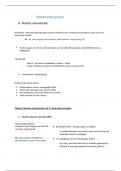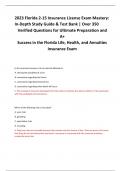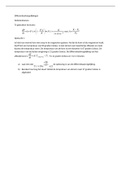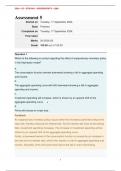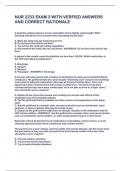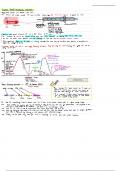Digital Food Marketing (blue = literature)
Lecture 1 – History, evolution and objectives of Food Marketing
Structure of course
- 7 lectures by Frans
- Exam (60%)
- Including 2 guest lectures
- 7 working groups by Ini
- Groups of 6 people
- Group assignment (40%)
- Solve problem with food marketing by theoretical and empirical work
- Final report and presentation (a pitch)
- Feedback session every work: 20 minutes
- Information session tomorrow 14:45-16:30
What is food marketing?
= Marketing that are about food products
- Marketeers communicate through an array of speech-based practices that included both
traditional “advertising” (e.g. billboards, television, radio and print ads) and broader
promotional strategies (PR communications and social media)
= Marketing is a broad concept that includes (1) speech-based communications, and (2) non-
speech related activities. In the first category, marketers communicate through an array of
speech-based practices that included both traditional “advertising” (e.g., billboards and
television, radio, and print ads) and broader promotional strategies (e.g., public relations
communications and YouTube, Facebook, and Twitter content). Food marketers and retailers
also engage in marketing practices that do not involve speech, such as establishing the price
of products and determining where to locate them within a store.
- Sometimes not [de bedoeling] to advertise on your social media
= Range of marketing techniques in order to add value to a food product and persuade the
consumer to purchase. This includes all activities that occur in between the completion of a
product through to the purchasing process of consumers
- Was persuasion the intention?
- Sometimes people lie
- Sometimes you didn’t mean to do that
- Recipient has free will so can decide for themselves
Marketingmix (4Ps)
1. Product: goods and services that company offers
- Achieve by creating new product or modifying or improving
- Assumes to consumers that there is something new when doing last two
2. Price: in order to influence to buy
- Or buy other products that are not related to advertised foods
- Try to make unhealthier food more expensive and healthier lower price
- Companies can manipulate price
- Fastfood price very cheap so that many people buy them
1
,3. Promotion: actions used to communicate food product’s features and benefits
- Persuading consumer to purchase the product
- Out of store, in store or on packaging
- On tv is used to attract consumer to go to store and buy it
- In magazines and newspapers may offer coupons
- More recent is online
- More influential and persuasive
- Companies manipulate you
- Part of information you receive is not real
Focus on this
4. Place: distribution and warehousing efforts necessary to move food from manufacturer to
location where consumer can buy it
- Or where product is located in retail outlet
- End of aisle, top, bottom, middle shelf, in special display case
- B or A products
Three (or four?) phases
1. Fragmentation phase: food marketing started end of 19th century
- Countries were divided into geographical fragments for food sales
- Used rail roads to transfer food
- Before it was too expensive and only sell locally
- Now it can be fresh
2. Unification phase (end of 19th-mid 20st century)
- Coordination of sales forces was made possible by telegraph and telephone
- Companies like Coca Cola and Heinz started selling internationally
- Advertising were among prime marketing tools
3. Segmentation phase (1950-current)
- Not only in printed media, but in mass media
- Radio and television + internet
- To wider range of people
- Different elements to add value + to make it more appealing
- More efficient distributions (flights, boats, trains, trucks)
- Sell worldwide
4. Personalized/tailored phase (2010-current)
- Increased immensely due to big data collections, AI, machine learning,
neuromarketing, eye-tracking
- Can tell what people want to consume?
Objective food marketing
- To increase sales
- Want to sell the product
- Show consumers that they want or need this product
- Persuade them or convey message
- Food industry influence health (obese/overweight/chronic diseases) and society
- Capitalism: coca cola has shareholders that make the decision
- Make highest profits of investments
2
,- Most people can afford to buy more food than they need competition
- Food industry compete fiercely (tastier, healthier, cheaper) & expend extraordinary
resources to develop market product that will sell
- Regardless of effect on nutritional status or waistlines
- Eat more of their product or eat their products instead of from competitors
- Through ads and PR
- Want you to buy 10, not 2
People eat too much, big effect on climate and overweight problems
- Ten largest food companies
1. Nestle
2. Pepsi
3. Coca Cola
4. Unilever
5. Danone
6. General Mills
7. Kellogg’s
8. Mars
9. Associated British Foods
10. Mondelez
Lot of other companies under them that they own and sell many products
- So difficult to go against them
- Blue zones: these people live for a very long time and they are very happy and healthy
- They eat very healthy
- Lot of vegetables and fruit
- Very small percentage unhealthy foods
- How can they eat good food and others don’t? Food marketing plays a large
role + very little money from food marketing spent on fruits & vegetables
- Island Samoa (from America): most obese nation
- Only buy process foods, don’t exercise and live “the American dream”
- Companies have to inform consumers where food has been bought
- Produced in Ireland & origin is Vietnam/India
- People think it is locally from Ireland because that’s what it says on the front
- Dual food quality: sold in different parts of the world
- We see differences and sometimes form of discrimination across products across
countries
- How to communicate this when it is not possible to have same packaging for
example?
- Most food products have to have date marking
- Safety communication from producers with end date
- Best before date (see it as end date, but is not necessary) or not good anymore
(safety)
- Use different information to improve communication around best before date
- To not make mistake of throw it away when it is still fine
3
, Information session - Working groups + assignment
- Planning of working groups will be available tomorrow or Friday
Assignment
- Will be solving a food problem for a company
- Find client with a food (marketing) question
- Develop RQ
- Find theoretical foundation
- At least 25
- Methodological plan + execution
- Outcome: report and (video) pitch
- Advice the client based on scientific knowledge and quantative/qualitative research
- Added value for client
- Ask client what they need
Outcome
- Report = 2500-3000 words
- 6 chapters
1. Executive summary with specifics recommendation
2. Introduction: problem statement & RQ
3. Theoretical framework/literature review
4. Methods
5. Results
6. Conclusion/discussion
- Video pitch (max 5 min + pass/fail)
Week 1: acquisition client
- If you found client, send Ini mail with client + their email
- Different functions?
- Indicate preference whether online or offline feedback
Week 2: problem statement and RQ
- Write research proposal (maximum 1 page)
- Draft version
- Problem statement
- Key concepts
- RQ
- Written feedback not actual feedback session
Week 3: research preparation
- Final problem statement/RQ
- 3-5 pages
- Supported by literature and methodological plan
- Material can be in Dutch
4
Lecture 1 – History, evolution and objectives of Food Marketing
Structure of course
- 7 lectures by Frans
- Exam (60%)
- Including 2 guest lectures
- 7 working groups by Ini
- Groups of 6 people
- Group assignment (40%)
- Solve problem with food marketing by theoretical and empirical work
- Final report and presentation (a pitch)
- Feedback session every work: 20 minutes
- Information session tomorrow 14:45-16:30
What is food marketing?
= Marketing that are about food products
- Marketeers communicate through an array of speech-based practices that included both
traditional “advertising” (e.g. billboards, television, radio and print ads) and broader
promotional strategies (PR communications and social media)
= Marketing is a broad concept that includes (1) speech-based communications, and (2) non-
speech related activities. In the first category, marketers communicate through an array of
speech-based practices that included both traditional “advertising” (e.g., billboards and
television, radio, and print ads) and broader promotional strategies (e.g., public relations
communications and YouTube, Facebook, and Twitter content). Food marketers and retailers
also engage in marketing practices that do not involve speech, such as establishing the price
of products and determining where to locate them within a store.
- Sometimes not [de bedoeling] to advertise on your social media
= Range of marketing techniques in order to add value to a food product and persuade the
consumer to purchase. This includes all activities that occur in between the completion of a
product through to the purchasing process of consumers
- Was persuasion the intention?
- Sometimes people lie
- Sometimes you didn’t mean to do that
- Recipient has free will so can decide for themselves
Marketingmix (4Ps)
1. Product: goods and services that company offers
- Achieve by creating new product or modifying or improving
- Assumes to consumers that there is something new when doing last two
2. Price: in order to influence to buy
- Or buy other products that are not related to advertised foods
- Try to make unhealthier food more expensive and healthier lower price
- Companies can manipulate price
- Fastfood price very cheap so that many people buy them
1
,3. Promotion: actions used to communicate food product’s features and benefits
- Persuading consumer to purchase the product
- Out of store, in store or on packaging
- On tv is used to attract consumer to go to store and buy it
- In magazines and newspapers may offer coupons
- More recent is online
- More influential and persuasive
- Companies manipulate you
- Part of information you receive is not real
Focus on this
4. Place: distribution and warehousing efforts necessary to move food from manufacturer to
location where consumer can buy it
- Or where product is located in retail outlet
- End of aisle, top, bottom, middle shelf, in special display case
- B or A products
Three (or four?) phases
1. Fragmentation phase: food marketing started end of 19th century
- Countries were divided into geographical fragments for food sales
- Used rail roads to transfer food
- Before it was too expensive and only sell locally
- Now it can be fresh
2. Unification phase (end of 19th-mid 20st century)
- Coordination of sales forces was made possible by telegraph and telephone
- Companies like Coca Cola and Heinz started selling internationally
- Advertising were among prime marketing tools
3. Segmentation phase (1950-current)
- Not only in printed media, but in mass media
- Radio and television + internet
- To wider range of people
- Different elements to add value + to make it more appealing
- More efficient distributions (flights, boats, trains, trucks)
- Sell worldwide
4. Personalized/tailored phase (2010-current)
- Increased immensely due to big data collections, AI, machine learning,
neuromarketing, eye-tracking
- Can tell what people want to consume?
Objective food marketing
- To increase sales
- Want to sell the product
- Show consumers that they want or need this product
- Persuade them or convey message
- Food industry influence health (obese/overweight/chronic diseases) and society
- Capitalism: coca cola has shareholders that make the decision
- Make highest profits of investments
2
,- Most people can afford to buy more food than they need competition
- Food industry compete fiercely (tastier, healthier, cheaper) & expend extraordinary
resources to develop market product that will sell
- Regardless of effect on nutritional status or waistlines
- Eat more of their product or eat their products instead of from competitors
- Through ads and PR
- Want you to buy 10, not 2
People eat too much, big effect on climate and overweight problems
- Ten largest food companies
1. Nestle
2. Pepsi
3. Coca Cola
4. Unilever
5. Danone
6. General Mills
7. Kellogg’s
8. Mars
9. Associated British Foods
10. Mondelez
Lot of other companies under them that they own and sell many products
- So difficult to go against them
- Blue zones: these people live for a very long time and they are very happy and healthy
- They eat very healthy
- Lot of vegetables and fruit
- Very small percentage unhealthy foods
- How can they eat good food and others don’t? Food marketing plays a large
role + very little money from food marketing spent on fruits & vegetables
- Island Samoa (from America): most obese nation
- Only buy process foods, don’t exercise and live “the American dream”
- Companies have to inform consumers where food has been bought
- Produced in Ireland & origin is Vietnam/India
- People think it is locally from Ireland because that’s what it says on the front
- Dual food quality: sold in different parts of the world
- We see differences and sometimes form of discrimination across products across
countries
- How to communicate this when it is not possible to have same packaging for
example?
- Most food products have to have date marking
- Safety communication from producers with end date
- Best before date (see it as end date, but is not necessary) or not good anymore
(safety)
- Use different information to improve communication around best before date
- To not make mistake of throw it away when it is still fine
3
, Information session - Working groups + assignment
- Planning of working groups will be available tomorrow or Friday
Assignment
- Will be solving a food problem for a company
- Find client with a food (marketing) question
- Develop RQ
- Find theoretical foundation
- At least 25
- Methodological plan + execution
- Outcome: report and (video) pitch
- Advice the client based on scientific knowledge and quantative/qualitative research
- Added value for client
- Ask client what they need
Outcome
- Report = 2500-3000 words
- 6 chapters
1. Executive summary with specifics recommendation
2. Introduction: problem statement & RQ
3. Theoretical framework/literature review
4. Methods
5. Results
6. Conclusion/discussion
- Video pitch (max 5 min + pass/fail)
Week 1: acquisition client
- If you found client, send Ini mail with client + their email
- Different functions?
- Indicate preference whether online or offline feedback
Week 2: problem statement and RQ
- Write research proposal (maximum 1 page)
- Draft version
- Problem statement
- Key concepts
- RQ
- Written feedback not actual feedback session
Week 3: research preparation
- Final problem statement/RQ
- 3-5 pages
- Supported by literature and methodological plan
- Material can be in Dutch
4

